30 September 2022
September 15th is the peak of hurricane season in Florida but we get almost as many hurricanes in October. With the devastation of Ian on the west coast of Florida, it got me to thinking about my experiences with hurricanes. By my count I’ve lived through five hurricanes and since I’ve been in Florida, I’ve had close calls with 13 tropical depressions, tropical storms and hurricanes. If you look at the historical map of tracks of hurricanes of Florida, you can see why.
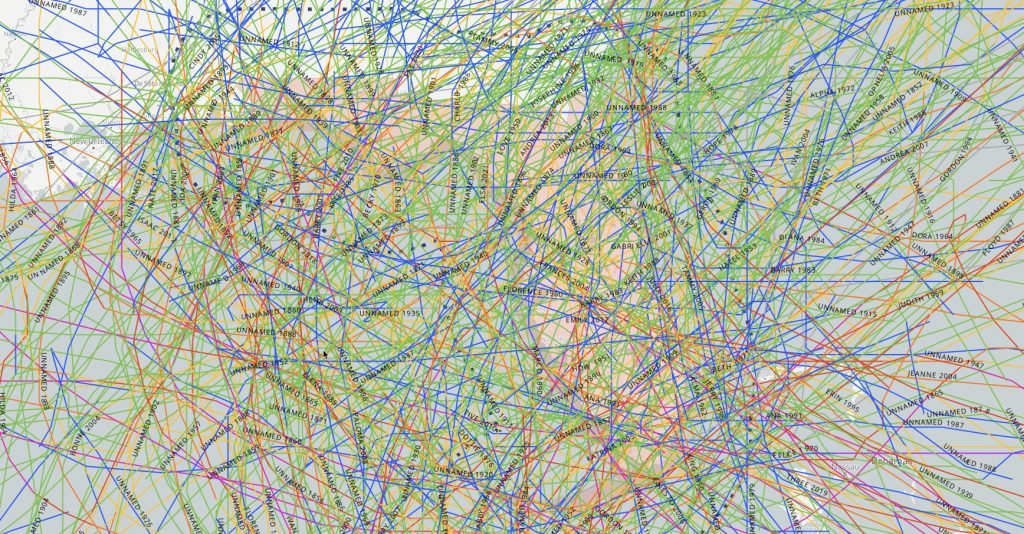
My very first hurricane experience was Hurricane Camille (August 17, 1969), a category 5 hurricane and the second most intense hurricane to strike the U.S. since the Labor Day hurricane of 1935 (in the Florida Keys). According to Wikipedia, the highest wind speed was 174 mph or 151 knots (1 knot = 1.15 mph) however, it was reported the anemometer on the Hotel Buena Vista in Biloxi blew off the roof at 200 mph. The hotel survived but barely.
It was my grandmother’s favorite place to stay while on the Mississippi Gulf Coast and I had a memorable run-in with a giant oak tree which grew up through a second floor patio. I think I still have the knot on my head. By the time Camille got to north Mississippi where I was at Ole Miss, it was still a pretty powerful hurricane.
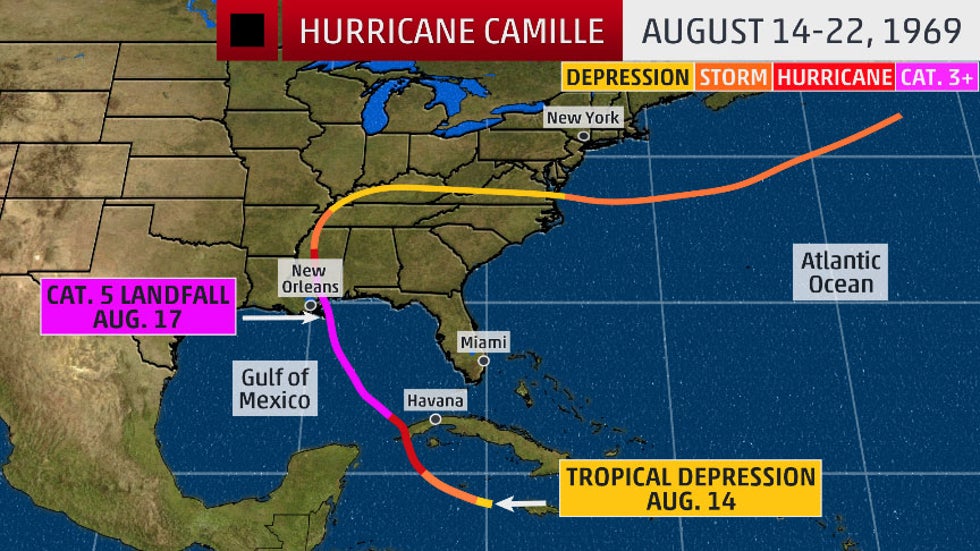
In 1970, I enlisted in the U.S. Coast Guard, went to boot camp in Alameda, California and Radio School at Governors Island, New York. I was sent to sea duty on board the CGC Reliance in Corpus Christi, Texas with very little sea experience. September turned out to be a busy month with two hurricanes near Corpus Christi: Edith and Fern. Strangely, Fern arrived first and then Edith.
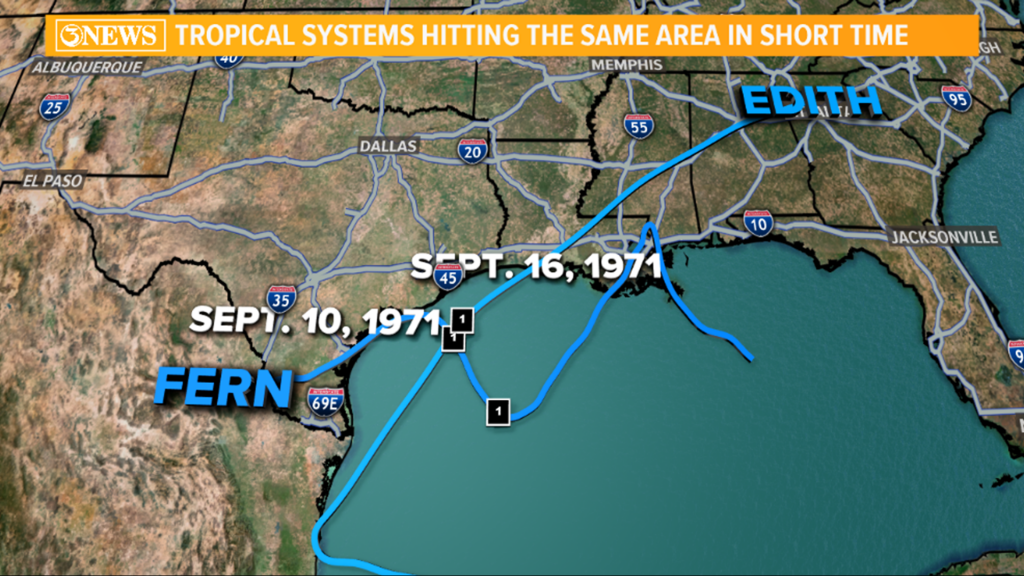
What a lot of people don’t know is that when a hurricane approaches, ships do everything they can to put out to sea and not stay in port to weather the storm. The reason is seen below.
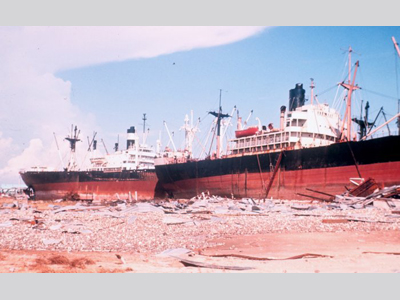
We put out to sea. A lot of people think the Gulf of Mexico can’t get rough because it is shallow compared to the Atlantic or Pacific. Not true. It doesn’t take much to make huge waves in shallow water. We were being hit by 50 foot seas and I copied one radio message from the CGC Dependable out of Brownsville, Texas that was towing a disabled shrimper off the coast of the Yucatan peninsula who reported 80 foot seas. Just to give you some perspective, from the keel to the top mast of the Reliance was 80 feet.
I remember sitting on the mess deck trying to keep food down when a wave washed over the side of the ship and through the water tight door (which apparently wasn’t so water tight) and flooded the mess deck. That will get your attention.
Hurricane Fern came through first and then Hurricane Edith. While at sea with Edith, three of the four engines on our ship failed. The Reliance was a prototype which had two diesel turbines and two diesel locomotive engines. We were down to one locomotive engine and could only do 4 knots. The hurricane was heading towards us at 5 knots. We limped back into port and rode the storm out in Corpus Christi Ship Channel. I got up the next morning and the mooring lines had been let out continuously during the storm and the gangway from the ship to the dock, normally at a 3-4 degree angle was now at a 65 degree angle. You literally had to climb the side of the ship to board.
Trust me to attract hurricanes. I moved to Florida in 1985 and moved to Fort Lauderdale in 1991. Hurricane Andrew struck on August 24, 1992. Even though Fort Lauderdale did not receive a direct hit, we certainly felt the effects. I lived in an evacuation zone and went to a public shelter (which was immediately declared unsafe) and we had to move to a second shelter. It was miserable. At dawn, without any sleep, I escaped and headed back to the house. The side of my condo was plastered in leaves. You almost couldn’t see the stucco.
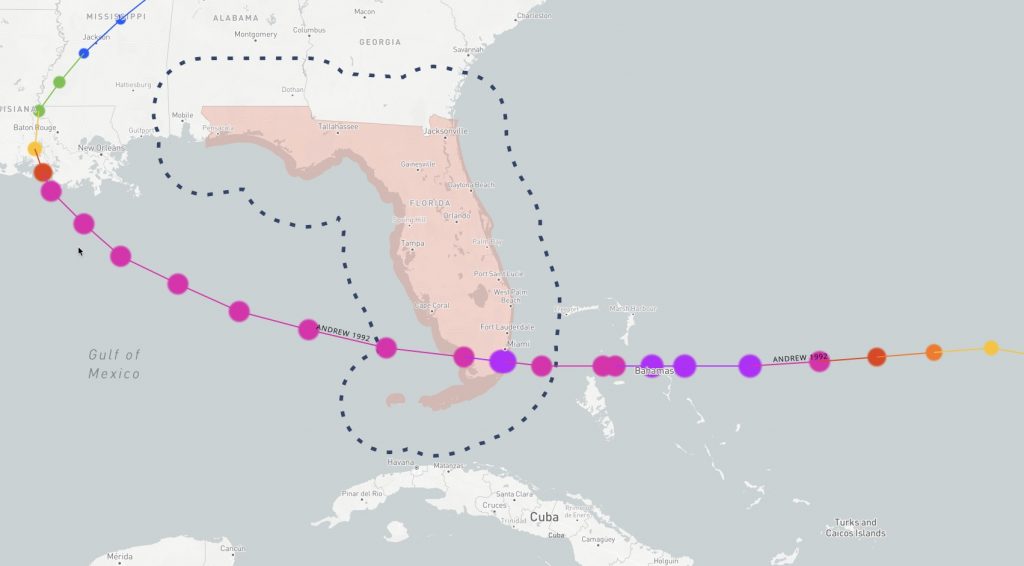
In 1995, I moved to my current home and in August 2005, I met Katrina. What’s interesting about that is I had ordered a stand alone generator to power the whole house. It was delivered but getting it installed was the problem. It sat, unconnected, in my driveway all during the hurricane. We were without power for 17 days.
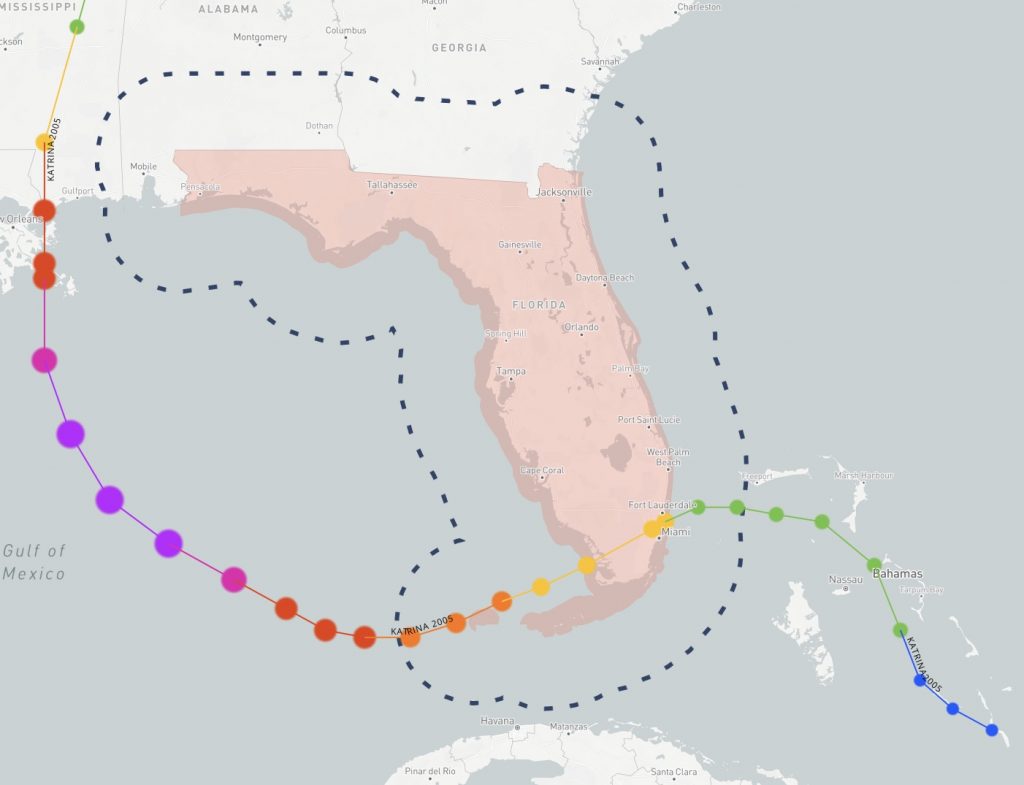
In October, Wilma struck. Again, the generator looked very efficient in my driveway. We were without power for 21 days.
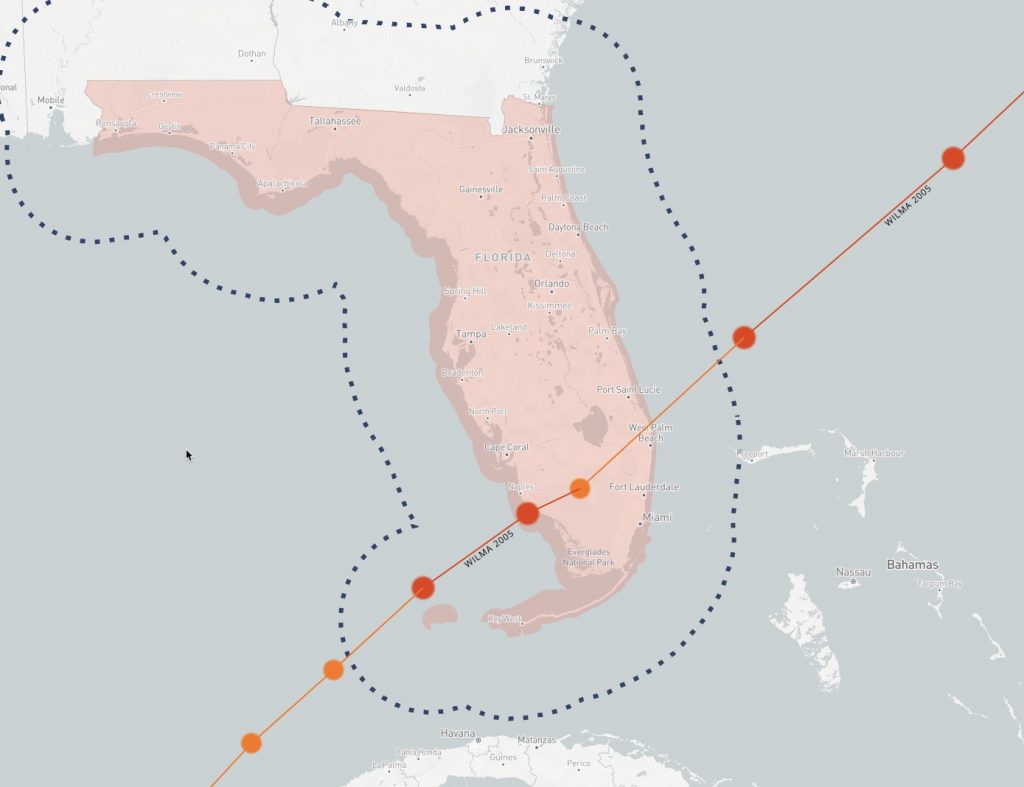
All the weather personnel told everyone that Wilma wouldn’t be too bad since it was coming through the Everglades to get to us. What they failed to take into consideration is there is not one mountain between the west coast of Florida and the east coast of Florida. It’s called the River of Grass for a reason. Wilma did far more damage than Katrina to Florida.
So here’s my breakdown.
Participating in and experiencing first hand:
August 17, 1969 – Hurricane Camille – Category 5 – 157 knots
September 13, 1971 – Hurricane Fern – Category 1 – 78 knots
September 15, 1971 – Hurricane Edith – Category 2 – 90 knots
August 24, 1992 – Hurricane Andrew – Category 5 – 150 knots
August 25, 2005 – Hurricane Katrina – Category 5 – 150 knots
October 24, 2005 – Hurricane Wilma – Category 2 – 95 knots.
In what I would call “Close but not quite” are near misses. They came very close to Broward County.
October 12, 1987 – Hurricane Floyd – Category 1 – 65 knots
June 30, 1991 – Tropical Depression Ana – 20 knots
October 16, 1991 – Tropical Storm Fabian – 40 knots
September 21, 1999 – Tropical Storm Harvey – 50 knots
October 16, 1999 – Hurricane Irene – Category 1 – 65 knots
August 30, 2006 – Tropical Storm Ernesto – 40 knots
July 23, 2010 – Tropical Storm Bonnie – 35 knots
September 30, 2010 – Tropical Storm Nicole – 40 knots
August 2, 2013 – Tropical Depression Dorian – 25 knots
September 3, 2018 – Tropical Storm Gordon – 45 knots
August 2, 2020 – Tropical Storm Isaias – 6o knots
September 12, 2020 – Tropical Depression Sally – 3 knots
November 9, 202 – Tropical Storm Etta – 55 knots
Remember, on all these near misses, hurricane panels went up for the first 10 years and then shutters, and finally impact windows and doors. You have to clean everything out of the yard to prevent missiles from being launched against your neighbor. Coconuts are deadly in a hurricane.
If you live anywhere on the eastern seaboard or around the Gulf of Mexico, hurricanes are a fact of life. At least, with todays forecasts, you have time to prepare. However, there are always those who don’t. Evacuation zones are clearly demarcated and if you have a radio or tv, you cannot miss that you may be in one, yet people do not evacuate. What they don’t seem to realize is the danger isn’t necessarily the wind – it’s the water that kills you.
I’m overly cautious. I have impact windows but I kept my shutters. I close them each and every time. I figure it is cheaper to replace a shutter than an impact window. I’m also a former Boy Scout and I stay prepared. I have water filtration systems I use when camping and they are handy to purify your tap water if pressure drops from the treatment plant. I have a portable toilet with disposable bags. I have freeze dried food for three weeks. I probably am too prepared.
These days, experts say if you are not in an evacuation zone (I am not) then you should ride out the storm. The reason is if you leave, your are likely to be snarled in traffic for hours on the roads out of here and you may run out of gas before you reach a station to refuel.
I’ve done everything I can do to protect my house. The house originally had roof tie downs to the walls every fourth rafter. Several years ago I put them on every rafter (as the arthritis in my hands can attest). Still, there are no guarantees with a category 5 hurricane.
The greatest danger from all the near misses (as well as direct hits) are tornadoes. Ian generously donated at least three to Broward County and we were no where near Ian. Studies of Andrew indicated that many homes and subdivisions were destroyed by microbursts and F1 tornadoes, not from hurricane winds.
As a former Mississippian, I’m familiar with tornadoes. I’m the only one on my block who closed shutters for Ian. Everyone knew it would miss us but what they didn’t take into consideration were microbursts and tornadoes in the county which led to some fairly significant destruction in western Broward. The best thing I can say about hurricanes is they give you warning. Tornadoes don’t.
Stay safe!

You should probably add Irma to your panoply of storms. I think it was the worst here in Broward, though Wilma was no slouch. If you can shelter from a tornado, thru are preferable. Nothing is left. You can get your insurance check and start anew.
Sorry about the typo. They, not thru.
Yea, you’re right. I meant to include it but I was reading from a hand written list and probably forgot it.
I remember well the devastation Camille caused on the Mississippi Gulf Coast. I also remember the hurricane lamps (kerosene lamps) we lit when the power went out. We had so many tornadoes spawned from the hurricanes, that we feared tornadoes much more in Mississippi.